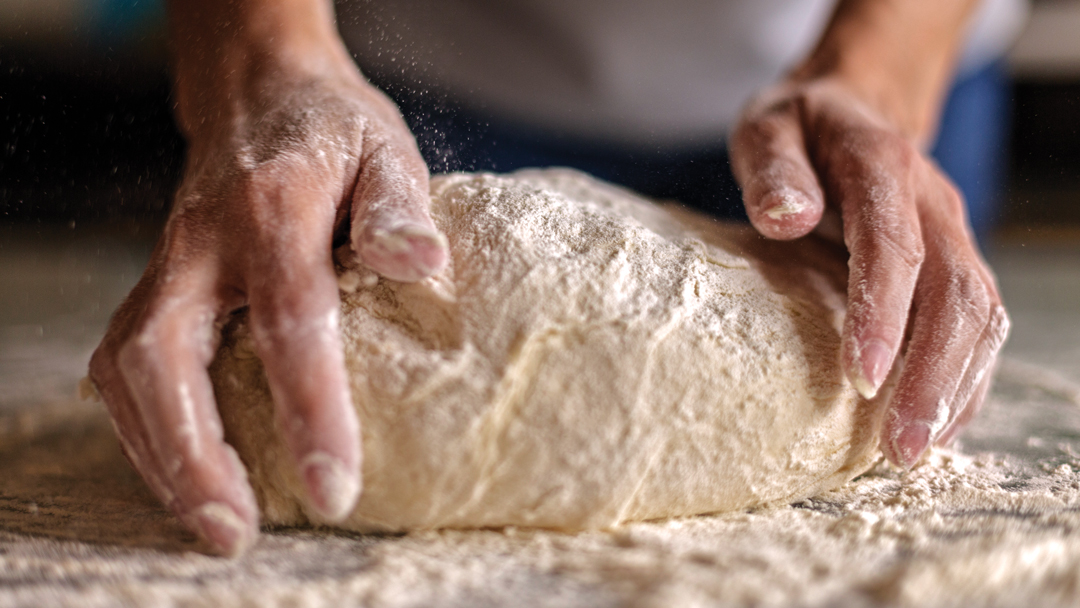FLOUR POWER
BY GEOFF GEDDES • PHOTO: ISTOCK
When it comes to hot Canadian commodities, flour takes the cake. Over the last several years, domestic demand for flour and baked goods has steadily grown. As factors such as immigration, higher personal incomes and the evolution of consumer tastes drive this trend, the industry hopes a healthy appetite for flour will be baked into our economy for years to come.
“Population growth is a fundamental driver of increased domestic demand for Canadian flour,” said Olivier Lavigne-Lacroix, president of the Canadian National Millers Association. “As Canadians become more health conscious, there’s growing interest in the natural nutrients found in wheat. At the same time, higher disposable incomes have enabled consumers to explore premium and niche baking products, contributing to the growth of the flour market.”
The COVID-19 pandemic sparked a significant increase in home cooking and baking as consumers spent more time at home. “Also, with higher immigration, ethnic communities in Canada are using our flour for chapatis [Indian flatbread] and Asian noodles, and durum wheat is highly regarded for pasta,” said Martin Barnett, executive director of the Baking Association of Canada (BAC).
NUMBERS TELL THE STORY
The numbers look good for the Canadian flour sector. Canadian flour production has increased by 2.8 per cent, from 2,451,268 metric tonnes in 2019 to 2,519,915 metric tonnes in 2023, noted Leif Carlson, director, Market Intelligence and Trade Policy at Cereals Canada. “Demand is forecast to continue to grow for wheat flour and baked goods at an annual rate of around 1.3 to 1.6 per cent.”
While Carlson also points to increased population as a factor, he sees efforts by industry as a key driver. “Work done by the Canadian Wheat Nutrition Initiative (CWNI) and their ‘What About Wheat?’ campaign promotes the health and nutritional benefits of wheat in a way that is accessible and understood by consumers in Canada,” he said.
Of course, farmers, millers and bakers are aware of the T-word these days, and it’s not toast. “Our research shows that it is simply too early to measure the direct impact of tariffs,” said Lavigne-Lacroix. “Many millers are still assessing the potential effect of this country’s trade war with the United States, but they expect it to be significant.”
In many respects, it’s a case of what you don’t know can hurt you.
DEFINITE UNCERTAINTY
“There is a lot of uncertainty about the overall tariff situation right now,” said Carlson. “The Canadian cereals value chain is trying to make the case that tariffs on trade in food should be avoided. The imposition of tariffs will increase prices for consumers while reducing margins for grain producers and food processors on both sides of the border.”
Like many industries in Canada, the flour business has faced more questions than answers about tariffs. “What will the tariffs be? Will they be countervailing? Will our sector be exempt?” said Barnett. “We have lobbied that if they are going to put countervailing duties on imported baked goods, they should restrict them to finished products and not ingredients. Our sector has material going to the U.S. and coming back as partially made products that are then finished in Canada. If we get 25 per cent tariffs going down and coming back, it’s like shooting yourself in both feet.”
Given the stakes, trade issues are critical to the industry. “We reached $18 billion in annual baking production in Canada for 2024,” said Barnett. “About $7 billion of that was exported, of which $5.9 billion went south of the border.”
Apart from the economic impact, tariff concerns have forced stakeholder groups to invest tremendous time and energy that might have been directed elsewhere.
TARIFF TALK
“The tariff threat has consumed a huge amount of bandwidth in the last several months,” said Barnett in May. “We have been talking to anybody and everybody in the supply chain: members, media, local ag producers, Global Affairs Canada and Innovation, Science, and Economic Development Canada. With so much up in the air, we sometimes have to talk people off the roof who are really distressed about it all.”
Across the country, groups such as BAC seek to develop stronger interprovincial trade and adjust to weather the storm. “Whether it was droughts, floods or train and port strikes, we have endured serious obstacles in the past,” said Barnett. “Each one impacted our sector in a major way, but we figured them out. Somebody once said business isn’t easy; if it was, everyone would do it. Look at those who survived the pandemic downturn or higher input costs and are stronger because of that. This is another challenge, and we will deal with it as it comes.”
WHEAT INTO GOLD?
While many fear another gathering trade storm on the horizon, it appears even the tariff cloud may have a silver lining. “The threat of tariffs has prompted us to think about expanding our markets to countries other than the U.S. and caused provincial governments and Ottawa to work on making trade easier between provinces,” said Barnett.
“It costs significantly more to ship interprovincially than to the States, and one of our members in B.C. said it was less expensive to send his product to China than to Ontario,” said Barnett. “Everything is more expensive in Canada, from paying drivers to maintaining infrastructure. That money helps make our country a great place to live, but we also have to charge more because our population is only 40 million, and we don’t have economies of scale like the U.S. with its 340 million people.”
The retail and wholesale picture for baked goods production is more than a domestic phenomenon. “It is a positive sign that we continue to see an increase in domestic demand, and we have witnessed continued growth in wheat demand globally,” said Carlson. “According to the International Grains Council, the 2023/24 marketing year saw a global record wheat consumption of 807 million metric tonnes. Canada’s wheat is sold around the globe, and wheat remains a staple food, with population and economic growth contributing to higher consumption.”
Canada has fostered strong growth in the export of baked goods, flour and baking mixes. From 2020 to 2024, export volumes grew by 33 per cent, further adding to demand for wheat-based products made in Canada, said Carlson. “The vast majority of exports of these products, and therefore export growth, has been to the U.S. market.”
While the tariff cloud hovers, there are reasons for hope in Canada’s flour sector, with quality being No. 1. “We’re not the automotive business,” said Barnett. “Most of our investments are covered by the Canada–United States–Mexico Agreement, and those that aren’t covered are not significant. The general mood today is one of not panicking; the sky hasn’t fallen yet. We are generally an optimistic bunch right now. The baking sector in Canada is doing very well as we produce amazing products, so even if there are price adjustments, people will still buy Canadian flour.”






Comments